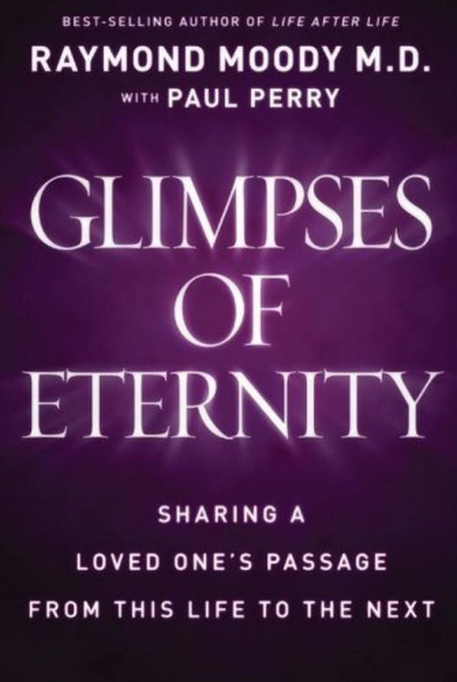
Reviewed by Tom Ruffles
Raymond Moody is best known for his pioneering work on near-death experiences (NDEs), as described in his ground-breaking 1975 book Life after Life. While the field has developed at a prodigious rate, he has maintained his reputation as an ambassador for the subject, his expertise in both philosophy and medicine having made him well-placed to analyse and discuss this enigmatic phenomenon.
In Glimpses of Eternity (2010) he examines a related but relatively little-studied topic, shared death experiences, in which a dying person links with the living at the moment of transition in a manner that bears some similarity to the NDE. The book is heavy on anecdote, in keeping with its tentative, exploratory nature, but the weight of testimony suggests that there is something happening beyond fantasy that appears, like the NDE, to give a glimpse of some state beyond death into which the dying person is entering.
Where shared-death experiences crucially differ from NDEs is that the reporters are healthy individuals and cannot be charged with brain malfunction. Yet they say that they have witnessed those at the point of death cross over and not return – even on occasion joining them for part of the way – accompanied by such phenomena as bright light, unearthly music, mist, an apparent change in the shape of the room, deceased relatives or ‘angelic’ beings who have come to escort the dying person into a new existence; in short events which seem to provide strong evidence that death is not the end.
Moody says that, as is the case with the NDE, not everybody goes through the same elements in a fixed pattern, but there is a core set which witnesses recount time after time that implies something real. Further, the fact the healthy can participate in the passing of someone suggests the shared death experience is more important than the NDE in providing evidence of an afterlife as it is immune to reductionist medical explanations. He also makes the point that the sharing does not need to be with a loved individual; the same thing happens in hospitals to nursing staff, ruling out stress at the loss of a loved one as a factor.
It is surprising that these shared death experiences have been so little studied, considering the research that has been carried out on NDEs and how closely related the two seem to be. Moody attempts to show that shared death experiences have a pedigree, and he discusses Sir William Barrett’s 1926 book Death-Bed Visions, in which there is also a linkage between healthy individuals and the dying. However, there is a qualitative difference between the examples he takes from Barrett, and a number of nineteenth century cases he recounts, and those from his own files which exhibit a transcendental component and have more in common with aspects of the NDE than do those earlier ones.
This is a very personal book in which Moody is happy to discuss his family’s shared death experience when his mother died. He is open about his religious convictions and belief in God. For many readers this will go too far as there is no necessary link between either shared death experiences or NDEs with the existence of a deity. Even the contention that shared death experiences are indicative of an afterlife is premature, despite the collection of reports Moody has amassed, because we know too little about the way they work.
Moody says that in his international lecturing he has found that shared death experiences occur worldwide, and it is highly likely that they have been underreported. He has provided a service in opening up this topic for discussion, just as Life after Life stimulated research into NDEs. He concludes by putting forward various ideas for what may be happening in the shared experience but concedes they are speculative, and he finally wonders if a definitive conclusion will remain elusive. That may be the case, but hopefully other researchers will apply more rigorous methods in an effort to understand what is happening. If NDE research feels like it is going round in circles, possibly an examination of shared death experiences will provide a breakthrough. Glimpses of Eternity provides a lot to ponder, but there is much to be done before a consensus on their meaning is reached – if it ever is.
The original title was Glimpses of Eternity: Sharing a Loved One’s Passage from this World to the Next, but the subtitle was amended to a pithier An Investigation into Shared Death Experiences. The change also perhaps reflects the fact that the sharing need not be between loved ones.
A separate review of Glimpses of Eternity, by Robert McLuhan, appeared in the October 2012 issue of the Journal of the Society for Psychical Research.

